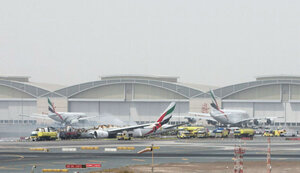How did all 300 passengers escape the Emirates jet?
American safety protocol – and fast-acting crew – are responsible for the safe evacuation of all onboard after a plane's crash landing in Dubai.

An Emirates Airline flight is seen after it crash-landed at Dubai International Airport on Wednesday.
Stringer/Reuters
When the Emirates Flight 521 came in for a landing Aug. 3 at Dubai International Airport in the United Arab Emirates, something went wrong. The pilot reportedly got on the loudspeaker before the descent to alert passengers that they would make an emergency landing. And when the Boeing 777 set down, it skidded across the tarmac, catching on fire. Videos taken from outside the plane show plumes of smoke rising up from the vehicle.
Yet all 300 people on board were able to escape before the fire engulfed the plane.
This may be largely because of regulations put in place by the US Federal Aviation Administration, which require that aircraft manufacturers design their planes to allow complete evacuation within 90 seconds. The rule applies to small regional jets, CBS News reports, like the Emirates jet, which had been arriving from Thiruvananthapuram, India.
As smoke filled the cabin, passengers were instructed to leave all their luggage behind and were ushered out of the plane via slide by the captain and crew.
According to an FAA advisory notice on emergency evacuation demonstrations, a set time limit for evacuations was established in 1965, when flight operators were required to conduct full-scale evacuation run-throughs, which limited evacuation to two minutes and used only half the available exits. In 1967, airplane manufacturers were required to conduct demonstrations of full evacuation in less than 90 seconds.
These requirements have morphed somewhat over the intervening decades and new pieces have been added, such as demonstrations that take into account more variables such as age and gender of passengers or contingencies like an evacuation not being able to go through off-wing exits. However the 90-second FAA rule pervaded.
"It's incredible how fast you can get people out of an aircraft," Christine Whitten, a former United Airlines flight attendant who experienced a similar incident, told CBS. "Once you learn the procedures, you don't forget them. And so you just go into that mode – and it's a very unusual kind of experience – but it basically saves lives."
While the Emirates airline is UAE-owned and operated out of Dubai, the plane was under the FAA regulations as a product of American company Boeing. Moreover the FAA has created a system that enables it to function as an international safety advisory board, despite its unilateral status as an agency of a single country.
This flies, so to speak, because the FAA has the power to restrict which carriers and countries can land planes in American airports. As part of an international aviation safety program, the FAA assesses different countries' aviation governing bodies to see how they regulate flight safety and aircraft condition. If a country’s practices do not meet certain standards they are barred from US landings or from increasing the number of flights that they run to the United States. In addition, they may be required to undergo inspections on US soil.
A spokesperson for Emirates said that the servicing and inspections for the aircraft were up to date. Emirates is the world’s biggest airline by international traffic, The Wall Street Journal reports, and the biggest operator of Boeing’s 777 aircraft. The airline has seen two other accidents take place on runways – in 2004 and 2009 two flights had similar accidents related to improper take-off.
While no more information has been released about the cause of the crash landing, an investigation is underway by UAE authorities. It is likely that plane maker Boeing and the US National Transportation Safety Board will also be involved in the crash probe.

